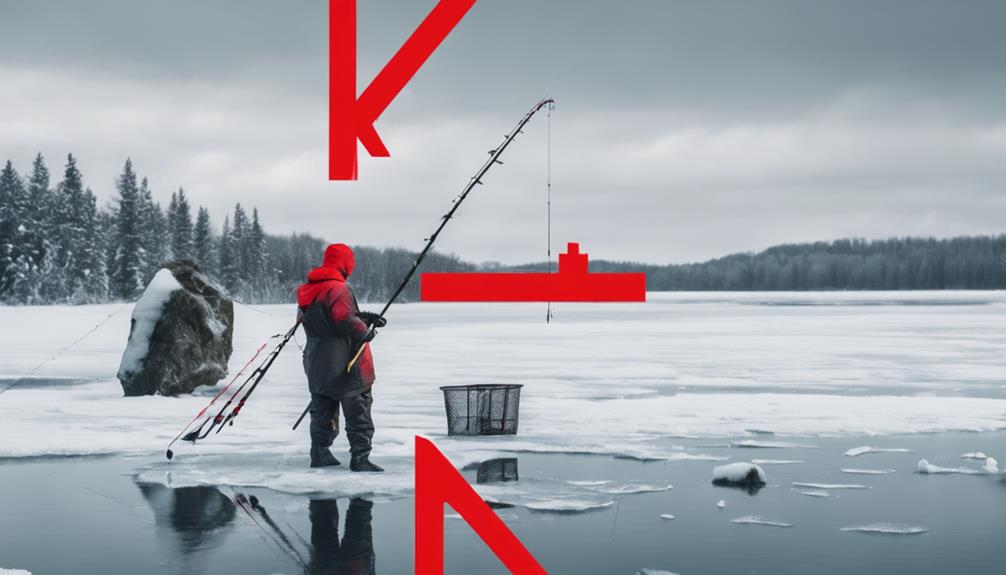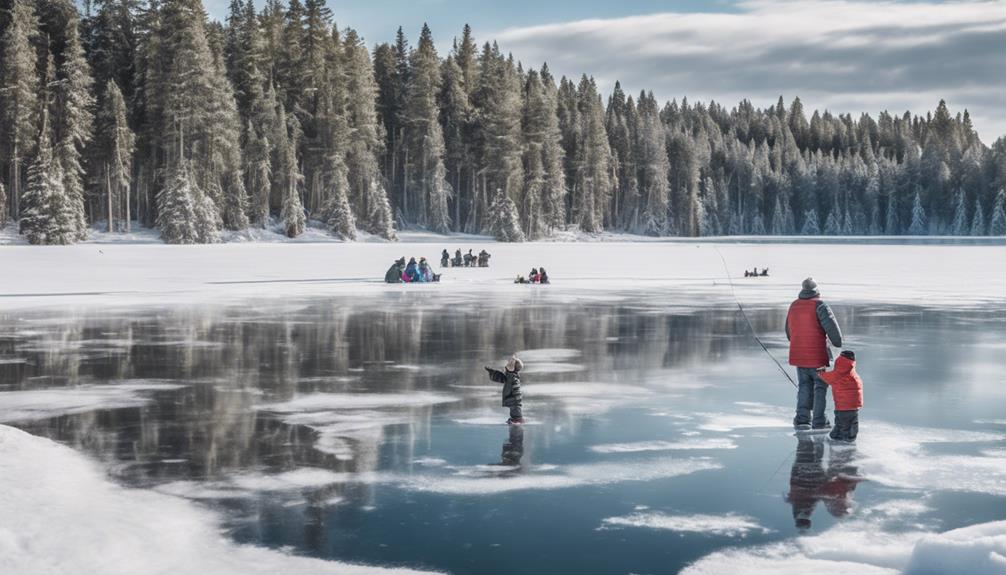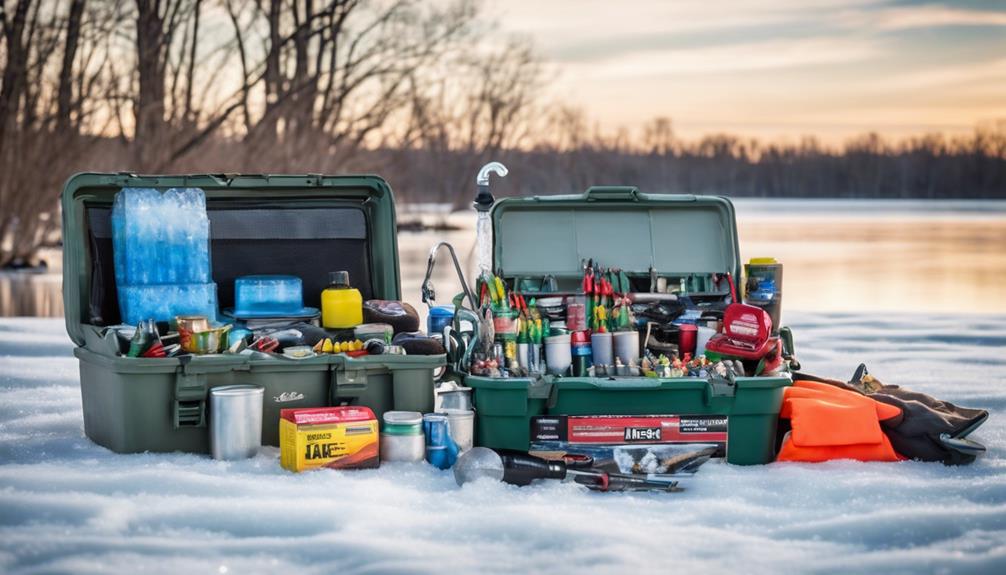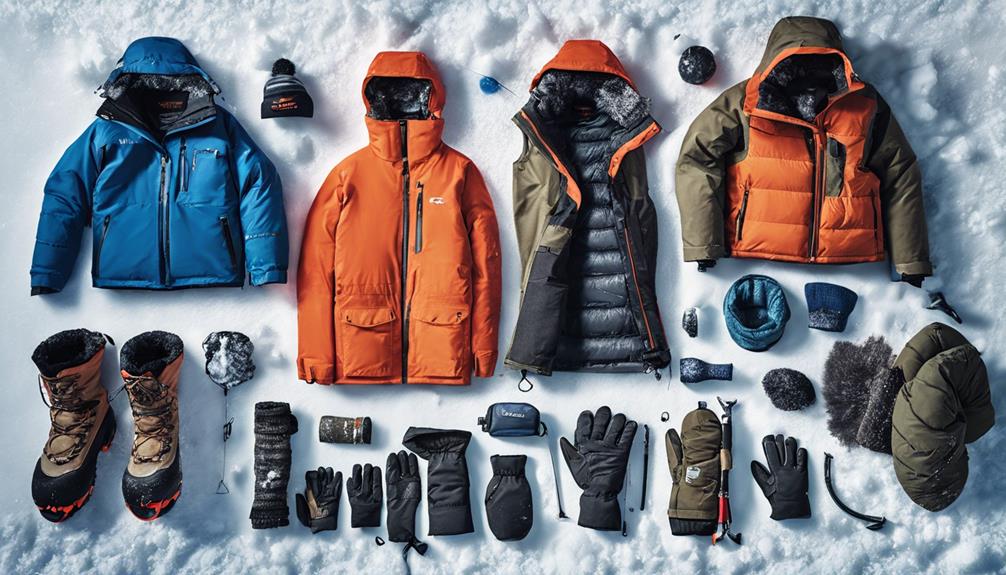Imagine setting out on a serene frozen lake, drilling your ice fishing hole and casting your line, hoping to reel in a prize catch. Just like navigating through a maze of frozen possibilities, Canada's ice fishing regulations can seem complex at first glance.
However, understanding these rules is crucial to ensure the sustainability of our aquatic ecosystems and the safety of all ice anglers. So, let's unravel the intricate web of regulations governing this time-honored winter pastime in the Great White North.
Ice Fishing License Requirements
To legally ice fish in Canada, you must obtain a fishing license. This requirement applies to all individuals engaging in ice fishing activities, regardless of age. However, there are certain exemptions to this rule. For instance, in some provinces, children under a certain age may be exempt from needing a fishing license. It's essential to check the specific regulations in the province where you plan to ice fish to determine if any exemptions apply to you.
When it comes to age restrictions for obtaining a fishing license in Canada, these rules can vary by province. Generally, individuals below a certain age aren't required to have a fishing license to participate in ice fishing. This exemption aims to encourage youth participation in outdoor activities and to introduce them to the joys of fishing. However, adults supervising children who are exempt from having a license may still need to have their own valid fishing license if they intend to fish alongside the children.
Understanding the license exemptions and age restrictions regarding ice fishing in Canada is crucial to ensure compliance with the regulations. By familiarizing yourself with these rules, you can enjoy a stress-free ice fishing experience while respecting the legal requirements in place. Always remember to check the specific regulations in the province you plan to visit, as these rules can differ across the country.
Designated Ice Fishing Areas
Check out the designated ice fishing areas in Canada to plan your next fishing adventure. When heading out to these areas, it's essential to be mindful of fishing etiquette to ensure a positive experience for yourself and others. Respect fellow anglers by giving them space, keeping noise levels down, and cleaning up after yourself. Following these simple guidelines contributes to a harmonious environment on the ice.
Designated ice fishing areas are chosen with careful consideration of their environmental impact. These locations are selected to minimize disturbance to wildlife and their habitats. By fishing in these designated spots, you can help preserve the natural balance of the ecosystems. Be sure to familiarize yourself with any specific regulations or guidelines for the area you plan to visit. Respecting these rules not only protects the environment but also ensures that these areas remain open for future generations to enjoy.
Before setting out on your ice fishing trip, take the time to research and identify the designated areas where ice fishing is permitted. By doing so, you can make the most of your experience while also promoting the sustainability of this popular winter activity. Enjoy the beauty of Canada's frozen landscapes while being a responsible angler in designated ice fishing areas.
Catch Limits and Species Regulations
Ensuring compliance with catch limits and species regulations is crucial for maintaining the sustainability of Canada's ice fishing practices. Size restrictions play a significant role in conserving fish populations. By adhering to these limits, you contribute to the preservation of various species and help maintain a balanced ecosystem. When anglers disregard size regulations, it can lead to detrimental effects on fish populations, disrupting the delicate environmental balance of the waters.
It's essential to understand the environmental impact of overfishing and the importance of responsible angling practices. As an angler, you hold a responsibility to fish within the specified limits to prevent overexploitation of fish stocks. By following these regulations, you actively participate in the conservation of Canada's aquatic habitats and ensure that future generations can also enjoy the thrill of ice fishing.
Ice Shelter and Equipment Rules
Comply with the regulations regarding ice shelters and equipment to ensure a safe and enjoyable ice fishing experience. When setting up your ice shelter, follow the guidelines provided to prevent any harm to yourself and the environment. It's important to note that leaving your ice shelter unattended for more than 24 hours is typically not allowed, as it can obstruct other fishermen and pose safety risks. Always check the specific rules for the area you plan to fish in, as regulations may vary between provinces.
In terms of equipment restrictions, certain items may be prohibited or have specific guidelines. For example, underwater cameras are restricted in some areas to prevent disturbance to the aquatic life. Additionally, there may be limitations on the types of heating devices you can use inside your shelter to prevent fire hazards. It's crucial to familiarize yourself with these rules before heading out onto the ice to avoid any fines or penalties.
Remember to pack out all your garbage, including any broken equipment, to keep the environment clean for others to enjoy. By respecting the ice shelter guidelines and adhering to equipment restrictions, you contribute to the preservation of the natural beauty of Canada's frozen lakes and ensure a positive experience for yourself and fellow ice fishing enthusiasts.
Safety Measures on Frozen Lakes
To ensure your well-being while ice fishing, familiarize yourself with essential safety measures on frozen lakes. When venturing out onto the ice, always remember that your safety is a top priority.
Here are some key safety measures to keep in mind:
- Check the Ice Thickness: Before heading out onto the frozen lake, make sure the ice is thick enough to support your weight. A minimum of 4 inches of clear, solid ice is generally considered safe for ice fishing. However, always use caution and check the ice thickness as you move further onto the lake.
- Wear Proper Gear: Dress warmly in layers to protect yourself from the cold. Wear insulated, waterproof boots and gloves to keep yourself dry and warm. A life jacket is also a crucial piece of safety equipment to have on hand in case of an emergency.
- Emergency Protocols: Familiarize yourself with emergency protocols before heading out onto the ice. Carry a whistle and a set of ice picks in case you need to pull yourself out of the water. Additionally, make sure to inform someone on land about your fishing plans and expected return time.
- Stay Alert and Aware: Always be aware of your surroundings and any potential hazards on the ice. Watch out for changes in ice color or cracks, and avoid areas with flowing water or vegetation that can weaken the ice. Trust your instincts and if something feels unsafe, err on the side of caution.
Conservation and Protected Areas
When ice fishing in Canada, it's important to be mindful of conservation and protected areas to help sustain the natural environment. Wildlife management and habitat protection are crucial aspects to consider while engaging in ice fishing activities. These conservation efforts ensure the preservation of diverse species of fish and other wildlife that call these areas home. By respecting designated protected areas, you contribute to the overall well-being of the ecosystem and help maintain its delicate balance.
Understanding the environmental impact of ice fishing is essential for practicing sustainable techniques. It's imperative to minimize any negative effects on the environment by following regulations and guidelines set forth to protect these areas. Adhering to sustainable practices such as catch and release, using biodegradable bait, and avoiding littering can significantly reduce the ecological footprint left behind while ice fishing.
Conservation and protected areas play a vital role in maintaining the beauty and biodiversity of Canada's natural landscapes. By being environmentally conscious and respecting these areas, you aren't only ensuring their longevity but also contributing to the preservation of these habitats for future generations. Remember, every action you take while ice fishing can either positively or negatively impact the environment, so make sure to prioritize conservation efforts during your fishing excursions.
Prohibited Fishing Practices

To protect the integrity of Canada's aquatic ecosystems, certain fishing practices are strictly prohibited. It's crucial to abide by these regulations to ensure the sustainability of fish populations and their habitats.
Here are some prohibited fishing practices that you must avoid:
- Illegal Baiting: Using unauthorized baits such as live fish or non-native species can introduce diseases and invasive species to the waters, disrupting the natural balance and harming native aquatic life.
- Overfishing Risks: Harvesting fish beyond sustainable limits poses a significant threat to the population dynamics of various fish species. It can lead to declines in fish stocks, affecting the overall health of aquatic ecosystems.
- Using Restricted Gear: Certain fishing gear, such as explosives or chemicals, are prohibited due to their destructive nature and potential harm to marine life and habitats.
- Targeting Protected Species: Intentionally fishing for protected or endangered species is strictly forbidden. These species require special conservation efforts to prevent their decline and possible extinction.
Reporting Violations and Penalties
If you witness any violations of Canada's ice fishing regulations, promptly report them to the appropriate authorities to ensure enforcement and deter future infractions. Enforcement procedures for ice fishing violations in Canada are taken seriously to protect the environment and sustain fisheries. When violations occur, fines are imposed to discourage illegal practices and maintain the integrity of the fishing regulations.
Reporting mechanisms play a crucial role in upholding ice fishing regulations in Canada. By reporting violations promptly, you contribute to the enforcement procedures and help authorities take necessary actions. The consequences for violating ice fishing regulations can include substantial fines, confiscation of equipment, and potential legal action. These penalties serve as a deterrent to prevent individuals from engaging in prohibited fishing practices.
To report violations, you can contact local conservation officers, fish and wildlife authorities, or the Ministry of Environment. Providing detailed information about the violation, such as the location, description of the incident, and any relevant evidence, is essential for effective enforcement. Your cooperation in reporting violations not only helps maintain the sustainability of Canada's fisheries but also promotes responsible fishing practices among the community. Remember, by reporting violations, you play a vital role in preserving the natural resources for future generations.
Frequently Asked Questions
Can Children Under a Certain Age Ice Fish Without a License?
Yes, children under a certain age can ice fish without a license. Age restrictions vary depending on the location, so it's important to check the regulations in your area.
Safety precautions should always be taken when allowing children to participate in ice fishing activities to ensure their well-being. Remember to provide proper supervision, appropriate gear, and educate them on the risks associated with ice fishing.
Are There Any Restrictions on the Types of Bait That Can Be Used for Ice Fishing?
When choosing your bait for ice fishing, remember to consider the type of fish you're targeting. Some popular options include minnows, worms, and artificial lures. Different baits work better for different species, so it's good to do some research beforehand.
Experiment with different bait selection and fishing techniques to see what works best for you. Also, make sure to set up your ice shelter properly and follow safety precautions to have a successful and enjoyable ice fishing experience.
Is Ice Fishing Allowed on All Bodies of Water in Canada, or Are There Specific Restrictions?
Yes, ice fishing is allowed on many bodies of water in Canada, but there are specific restrictions in place for certain areas. When participating, remember to follow safety precautions and ensure you have the right equipment.
It's important to consider the environmental impact of ice fishing and support conservation efforts to protect these areas for future generations. Always be mindful of regulations and guidelines to preserve the beauty of these waters.
Are There Any Regulations Regarding the Disposal of Waste While Ice Fishing?
When ice fishing, it's crucial to consider proper waste management to minimize your environmental impact. Make sure to dispose of waste responsibly by taking it with you when you leave.
Leaving trash on the ice can harm the environment and wildlife. Remember to leave no trace behind and keep our waters clean for all to enjoy.
Proper waste disposal is key to preserving the beauty of our natural surroundings while ice fishing.
Are There Any Seasonal Closures for Certain Species of Fish During the Ice Fishing Season?
During the ice fishing season, some species of fish may have seasonal closures in certain areas. It's important to check the fishing seasons and regulations for specific catch limits and any restrictions before heading out on the ice.
Be aware of any closures that may be in place to protect fish populations during vulnerable times. Stay informed to ensure you're following all guidelines and regulations while enjoying your ice fishing activities.
Conclusion
Now that you have a better understanding of Canada's ice fishing regulations, make sure to always have your fishing license, follow catch limits, and use proper equipment.
Be aware of designated areas and conservation rules to protect our natural resources. Remember to prioritize safety on frozen lakes and report any violations to authorities.
By following these guidelines, you can enjoy a successful and responsible ice fishing experience in Canada.



